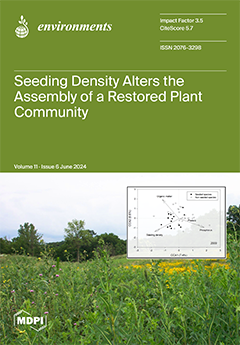The stability of soil organic matter (SOM) depends on its degree of physical protection, biochemical quality (
q), and mineralogical features such as the abundance of iron or aluminum oxyhydroxides: All constraints stabilize SOM, but the relevance of each is herein discussed.
[...] Read more.
The stability of soil organic matter (SOM) depends on its degree of physical protection, biochemical quality (
q), and mineralogical features such as the abundance of iron or aluminum oxyhydroxides: All constraints stabilize SOM, but the relevance of each is herein discussed. We studied from this point of view the stability of SOM in four grassland soils. The SOM in these profiles was characterized for its physical protection (ultrasonic dispersion + size fractionation) and its
q (acid hydrolysis, carbohydrates, phenolics, and unhydrolyzable carbon). The profiles were also analyzed for free iron forms extracted with several chemicals: dithionite-citrate-bicarbonate, citric acid, oxalic-oxalate (Tamm’s solution), and DTPA. Soil horizons were incubated under optimal conditions to obtain the C lost after 33 days (Cresp33) and basal respiration rate (BR
R). The microbial C was obtained at the end of the incubation. The microbial activity rate (MA
R: mg C respired per g microbial C per day) was obtained from these measures. The sum soluble + microbial C was taken as the active C pool. As expected, the stability of SOM depends on its distribution between the size fractions: The higher the proportion of particulate organic matter (POM: >20 µm size), the higher the soil respiration rate. In contrast,
q barely affects SOM decomposition. Both physical availability (size fractionation) and
q (acid hydrolysis) affect the size of the microbial C pool, but they barely affect MA
R. The effects of free iron on SOM stability are complex: While dithionite-extracted Fe negatively affected Cresp33, BR
R, and MA
R, the Fe extracted by smoother methods (Tamm’s reagent and DTPA) positively relates to Cresp33, BR
R, and MA
R. Free iron apparently modulates soil microbial metabolism because it is the only studied parameter that significantly affected MA
R; however, the precise effect depends on the precise free Fe fraction. From our data, SOM stability relies on a net of constraints, including physical availability and free Fe forms, with
q being of minor relevance. Our dataset suggests a role for free iron as a modulator of microbial activity, deserving future research.
Full article





